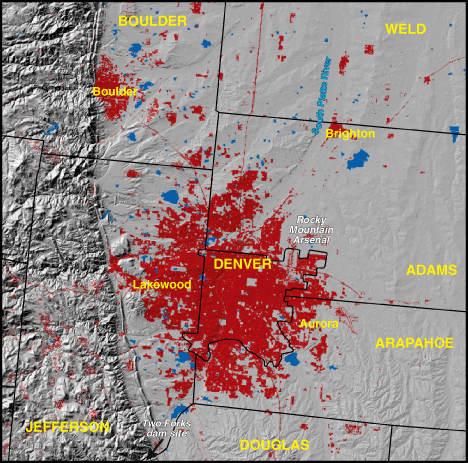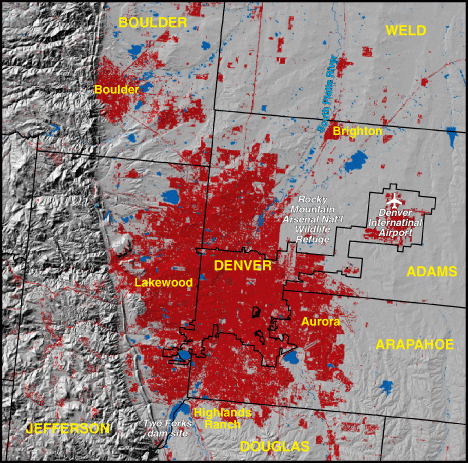Denver, Colorado 1973


|
1970 Population - 1,327,570
Includes Denver, Adams, Arapahoe, Douglas, Jefferson, Boulder, and Weld Counties. NOTE: portions of the above listed counties may not be visible on the map Red areas shown as developed land 175,400 acres (274 square miles) |
The Pike's Peak gold rush in 1859 resulted in a supply base along the South Platte River that became Denver. The new city grew by acquiring links to major railroads and evolving into a regional service center for agriculture and mining. The need for more water led to interbasin transfers from the West Slope by the early 1900s. The Federal Government helped spur growth during and after World War II by establishing defense facilities and a supraregional center for governmental agencies. Engineering-technology companies migrated to the area and fueled other industrial growth, including Denver becoming a regional oil business center. Other attractions for potential new residents were the moderate climate and the natural amenities of the Rocky Mountains. |
Denver, Colorado 1992

|
1990 Population - 1,980,140
Includes Denver, Adams, Arapahoe, Douglas, Jefferson, Boulder, and Weld Counties. NOTE: portions of the above listed counties may not be visible on the map Red areas shown as developed land 283,200 acres (442 square miles) |
The continued urbanization has raised several quality-of-life issues. Denver was one of the cities most dependent on motor vehicles by the 1970s and because of its higher altitude battled air pollution. Clashes over water resources have been frequent, including the defeat of the proposal to build the controversial Two Forks dam southwest of Denver, and shifting alliances have pitted the Front Range versus the Western Slope, Denver and its suburbs, and the northern Front Range against metropolitan Denver. The slowing of the area's rampant growth was made more difficult in the 1990s with the building of a massive new airport, a 48-mile "outer" beltway highway, and large planned communities, such as Highlands Ranch in Douglas County. |